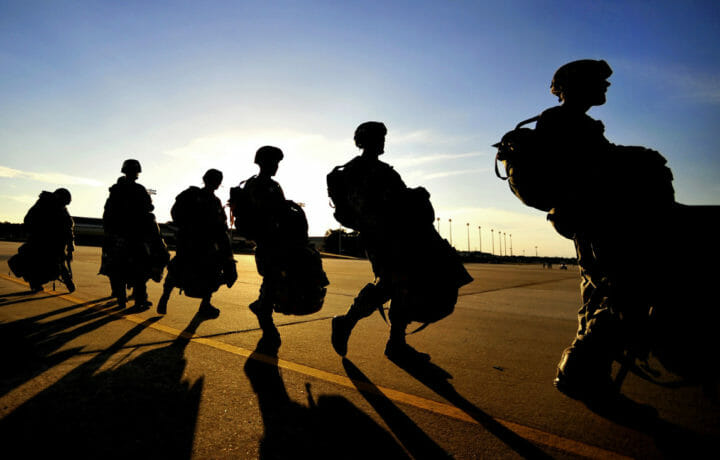There were several pieces of legislation in the Fiscal Year 2025 National Defense Authorization Act (NDAA) that were aimed at enhancing the National Guard and Reserves. The focus in this article is these three:
- Guard and Reserve GI Bill Parity Act of 2025
- Expanded Role of the National Guard in Border Security
- Establishment of the Space National Guard
Guard and Reserve GI Bill Parity Act of 2025
This bill is a bipartisan legislative effort aimed at expanding Post-9/11 GI Bill (PGIB) educational benefits to National Guard and Reserve members by recognizing all days of service in uniform. That is currently not the case as PGIB eligibility is dependent on the coding on the military orders; most codes used for National Guard Title 32 and even some Title 10 service are not PGIB eligible.
It was introduced in the House as H.R. 1423 by Rep. Mike Levin (D-CA) and in the Senate as S. 649 by Sen. Jerry Moran (R-KS) and Sen. Richard Blumenthal (D-CT). As noted, the bill seeks to address a longstanding disparity in education benefit eligibility between active-duty and reserve component service members.
The three key provisions of this important bill are:
1. Inclusive Service Recognition
The bill proposes that all forms of paid service—including weekend drills, annual training, military schooling, and disaster response—count toward PGIB eligibility. This encompasses both Title 10 and Title 32 federal duty statuses, ensuring that Guard and Reserve members receive credit for every day spent in uniform – the same as those military members serving on active duty.
2. Retroactive Applicability
The legislation is designed to apply retroactively to service performed on or after September 11, 2001, thereby benefiting a broad spectrum of current and former service members.
3. Delayed Implementation
To allow for administrative adjustments, the expanded eligibility provisions would take effect one year after the bill’s enactment.
H.R. 1423 was introduced in the House of Representative on February 18, and has been referred to the House Committee on Veterans’ Affairs. As of April 9, it was forwarded by the Subcommittee on Economic Opportunity to the full committee by voice vote.
In the Senate, S. 649 was introduced on February 20, and referred to the Senate Committee on Veterans’ Affairs. The bill’s progression through Congress and if passed will determine its eventual enactment and implementation.
Expanded Role of the National Guard in Border Security
The NDAA authorizes an expanded deployment and operational role in the use of National Guard troops to assist in controlling illegal immigration along the U.S.-Mexico border. This provision aims to bolster border security efforts by leveraging the Guard’s capabilities in surveillance, logistics, and infrastructure support. And the legislation provides more clarity on federal reimbursement to states deploying Guard troops for these missions – reinforcing the Guard’s role in supporting civil authorities.
Legal and Political Considerations
The expanded military involvement at the border has raised legal and political questions, particularly concerning the Posse Comitatus Act, which restricts federal troops from engaging in domestic law enforcement. While National Guard units under state authority (Title 32 status) can support civil authorities, their direct involvement in law enforcement activities remains limited. The current deployments focus on support roles, such as surveillance and logistics, to stay within the legal boundaries of this Act.
Establishment of the Space National Guard
The NDAA also includes provisions that authorize the transfer of certain space functions and personnel from the Air National Guard (ANG) to the U.S. Space Force (USSF). This move aims to integrate existing ANG space units into the Space Force’s structure, enhancing the nation’s space defense capabilities and adding a National Guard element to the newest active duty military branch.
The key provisions of this bill are:
1. Transfer of ANG Space Functions
The NDAA directs the Secretary of the Air Force to transfer the ANG space functions and personnel to the USSF. This transfer must be completed within eight fiscal years of the NDAA’s enactment.
2. Governor Consent Not Required
Unlike previous arrangements, this transfer does not require the consent of state governors, a point that has raised concerns among state leaders and the National Guard Association of the United States (NGAUS).
3. Personnel Protections
This Act of the NDAA stipulates that no individual Guard member can be transferred to the Space Force without their consent. Additionally, the Space Force is required, to the maximum extent practicable, not to relocate any individuals for three years following the transfer and to keep units in their current states for ten years.
The integration of ANG space units into the Space Force has been a topic of debate since the Space Force’s establishment in 2019. While the Department of the Air Force advocated for a unified Space Force structure without a separate Space National Guard, many lawmakers and state officials expressed concerns about losing state control over their National Guard units. The NDAA’s provisions reflect a compromise, allowing the transfer of functions while implementing measures to address personnel and state concerns.
The Fiscal Year 2025 National Defense Authorization Act (NDAA) includes significant legislative enhancements for the National Guard and Reserves, reflecting Congress’s recognition of their critical roles in national security. Collectively, these legislative actions highlight a strong commitment to bolstering the capabilities, support, and integration of the National Guard and Reserve components into broader national defense strategies.




